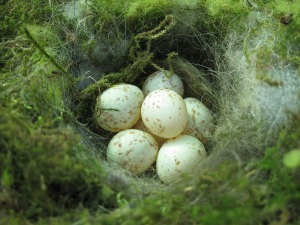With the beginning of another year and the next round of Level 1 “Behaviour of Humans and Other Animals” (APS126) on the horizon, I thought it would be a good time to highlight a few of my favourite animal behaviour studies from last year. Please feel free to post your own favourites in the comments section below!
First example of sex-reversed genitalia
Sex role-reversed species are fairly well-known, and most of us are aware of the female hyena’s pseudo-penis. But last year saw the first report of complete sex-reversal of functional genitalia. When a newly discovered group of Brazilian cave-dwelling insects known as Neotrogla (comprising four distinct species) were announced to the world, Yoshizawa et al. highlighted their most surprising feature – the females possess the penis-like genitals, and the males have something resembling a vagina.
The female “penis”, or gynosome is inserted into the male’s vagina-like orifice during copulation (which can last an impressive 70 hours) and collects sperm from the male, along with a nutritious nuptial gift. Interestingly, the gynosome has features similar to those reported for male penises of several other insect species, including spines that anchor the intromittent organ in position and can cause damage to the mating partner, leading to sexual conflict.
The full study, published in Current Biology, can be found here.
Hidden costs of social dominance in societies with unequal workloads
Social dominance is usually seen as a positive, adaptive trait – dominant individuals usually obtain the best resources and mates, and generally enjoy greater fitness as a result. However, in cooperative groups of white-browed sparrow-weavers Plocepasser mahali, where dominant individuals monopolise within-group reproduction, there is a disparity across the group in terms of workload. The dominant male and female invest the most in reproduction and work much harder than subordinates during the breeding season. This elevated workload could have knock-on effects for the long-term health and survival of dominant individuals.
In a study published last year, Cram et al. showed that, following the breeding season, dominant individuals experienced a decline in antioxidant defense compared with subordinates, an effect that was particularly strong in females (who invest the most in reproduction). Since antioxidant defense may protect against oxidative stress, this potentially puts dominant individuals at a greater risk of cellular damage and accelerated aging.
The full study, published in Functional Ecology, can be found here.
Play behaviour in fish
Play is an odd behaviour, because in contrast to many other behaviours with a clear purpose, play often appears to be pointless – a simple waste of the animal’s time and energy. As a result, early hypotheses for play associated its function with pleasure, enjoyment and entertainment, and restricted it to ‘intelligent’ or higher functioning animals. However, several studies have now provided evidence for play behaviour in a wide range of species, including those previously thought incapable of playing, such as reptiles and invertebrates.
The latest ‘player’ to be revealed is a humble cichlid fish. Burghardt et al. observed and studied three individual male Tropheos duboisi “playing” with objects in their tank, including a bottom-weighted thermometer. The fish repeatedly struck the thermometer, seemingly just for the fun of it. The fact that the weighted thermometer always popped back up to its right position following attack appeared to reinforce the behaviour, suggesting that the fish found this ‘reaction’ to their playfulness particularly rewarding.
The full study, published in Ethology, can be found here.
Cultural transmission and maintenance in birds
Culture is a familiar and fundamental aspect of human life. Cultures develop via the transmission of ideas and behaviours throughout societies, and this transmission is largely achieved by social learning. There has been little research on culture in non-human animals, with the exception of a few studies of other primate species.
Late last year, Aplin et al. published the results of a clever field experiment on a common UK passerine bird, the great tit Parus major. They demonstrated that the formation of cultural norms is not restricted to humans or primates, as had previously been assumed. Via social learning, stable behavioural differences were quickly established within great tit populations after the introduction of novel foraging behaviours (by trained individuals). The results of the study suggest that, similar to human societies, avian “culture” is largely driven by an individual preference for copying the majority (conformist learning).
The full study, published in Nature, can be found here.
Penguin robo-chick
Ok, ok. This isn’t technically a study of animal behaviour. However, I just couldn’t bring myself to exclude the development of this super-cool and super-cute method for gaining a more in-depth insight into penguin behaviour. The photos and videos say it all.
The full study, published in Nature Methods, can be found here.
